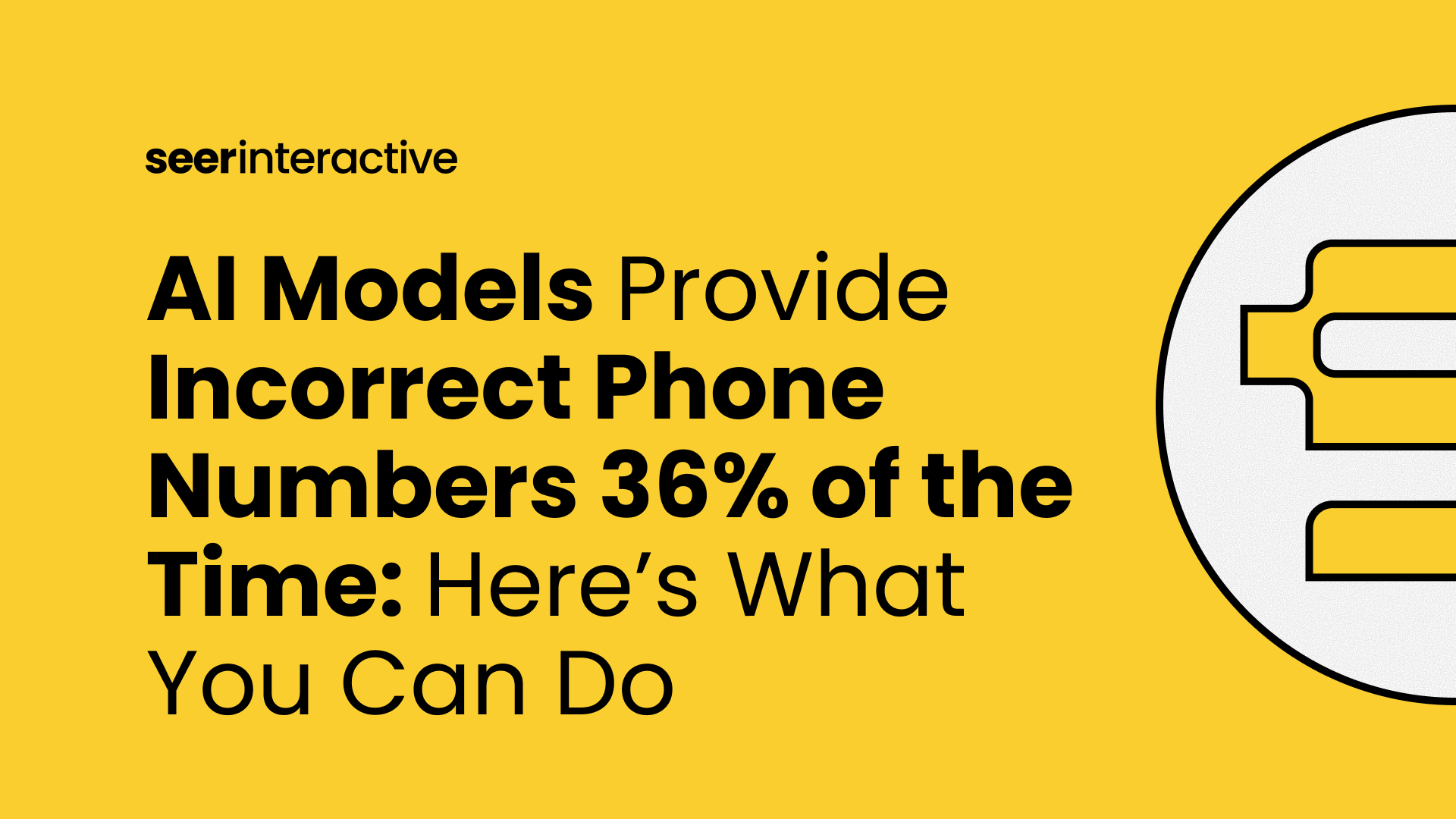4 Ways to Define ROI for your SEO Program
Proving ROI for marketing recommendations has always been important. Throw in a global pandemic, an increasingly nuanced digital landscape, and general economic uncertainty, and marketers are being asked to quantify and prioritize more than ever before.
Quantifying SEO ROI can be especially tough. We don’t have the targeting capabilities of social media ads, the guaranteed qualified audience that comes from the “push” nature of email marketing, or the keyword-to-page analytics of pay-per-click.
Never thought I’d be jealous of a marketing channel. But here we are.
As an emerging SEO consultant, I was often hesitant to commit to projections - it felt not only challenging, but scary. How am I supposed to know how much money a client will make after fixing a canonical tag?
Enter: Larry Waddell. Everything became clear for me after a single conversation in 2016 with our in-house Yoda (aka EVP of Digital).
The first thing he helped me understand about ROI is that the truth is - not every recommendation we give is going to make a client money.
But that’s okay. Why? Because some recommendations are going to save money, mitigate loss, or provide insurance for our client’s investments.
While every organization will have their own approach to calculating ROI specifics, everyone can start by understanding these 4 ways to define ROI.
ROI Type #1: Revenue ROI
What is Revenue ROI?
This one’s easy. Revenue ROI is net-new revenue a site would not otherwise gain without SEO.
Revenue ROI Examples:
- Optimizing a page for (relevant and valuable) keywords
-
Optimizations = Revenue. With a few steps in between :)

-
Building a valuable, engaging buying guide for an ecommerce site
-
A valuable, engaging guide is noticed by a popular blogger
-
The blogger reposts it to their site
-
The blogger’s readers see and visit the buying guide
-
More buying guide visits = more revenue
Tips for Calculating Revenue ROI:
-
Utilize Various Data Sources + Tools
-
From projecting out from MSV data to utilizing PPC query reports, there are many ways to calculate revenue.
-
If you need inspiration, check out Sharon Lunny’s post on how to calculate estimate ROI for SEO
-
-
Ask for the Data You Need
-
Not sure what your average order value is? Ask around. If the answer doesn’t yet exist, well-informed estimates are the next best thing.
-
Your estimates won’t be 100% accurate, but that’s okay. Because they will do something even more valuable: give stakeholders something to react to.
-
Keep Existing Revenue in Mind
-
If a page is currently gaining revenue, ensure you are taking that into consideration before finalizing your projections.
-
Consider the Cost to Create/Publish
-
Content creation and development resources aren’t free.
-
Unless you’re using ChatGPT exclusively. Which…more on this in “Cost Avoidance”
-
Account for the costs of these resources (and any others you’ll need) for an accurate and well-rounded ROI projection.
-
Think Long Term
-
SEO is a long game. Once a page, buying guide, or resource is up - it can provide revenue value for years to come. To that end, consider projecting out multi-year value.
-
Utilize Margins to Understand Bottom Line Impact
-
Not all products and services are equally profitable. As a bonus, add margin data to your calculations to ensure you are considering bottom line value.
ROI Type #2: Cost Savings
What is Cost Savings?
Cost savings are a result of initiatives that lower an organization’s current spending or investments. As a result, cost savings result in tangible financial benefit for an organization.
Cost Savings Example:
-
Adding FAQs and resources to a site
-
Providing “self serve” information on a site can reduce time spent from a customer service employee salary on payroll.
-
Online sample/swatch downloads
-
Providing information and high-resolution photos of fabric or material swatches can save shipping costs otherwise needed to send those materials to a potential customer.
-
CMS Upgrades
-
Migration to a new CMS is costly and time consuming. But you know what’s more costly and time consuming? Manually hard coding meta data for 10 hours a week. Investing in a new CMS (and the capabilities that come with it) often results in significant long-term gains.
Tips for Calculating Cost Savings:
-
Get Creative with Data Sources
-
Estimating cost savings can be simple (if we switch from tool X to tool Y, we’ll save $50k) or complex (if we publish FAQs, we can save 30 hours of Suzy’s time answering phone calls each week, which reduces our need to hire another full time employee.
-
Tracking is Key
-
If you don’t know how many people are downloading swatches or visiting FAQs on your site, you won’t be able to back into projections.
ROI Type #3: Cost Avoidance
What is Cost Avoidance?
Cost avoidance is investing in something now to avoid spending more in the future. In simple terms: measure twice, cut one. Unlike cost savings, the costs avoided are potential/estimated costs, as they are not yet being incurred.
Cost Avoidance Example:
-
Investing in Quality Content:.
-
It may be tempting to take a shortcut when in need of content by using low cost/low quality providers or relying heavily on AI generated content. But consider all potential outcomes.
-
For example, with Google's push for EEAT, what are the odds your content will deliver the results you're hoping for?
-
Don't make a medium investment today that will need to be replaced by a large investment tomorrow.
-
Site Migration Support
-
Ensuring all technical site elements are sound throughout a migration can take a lot of time (and money).
-
While no one wants to delay a site launch in order to fix a technical issue, consider the cost of not doing so. Not only will organic performance take a hit, you may need to pull in extra/overtime resources to remedy the issues once the site is live.
Tips for Calculating Cost Avoidance:
-
Consider Long Term Cost:
-
The idea is easy: Whenever you are considering a short term benefit, always consider the long term cost.
-
In practice, it’s not easy. To help with consistency, assign the task of focusing on long term costs to someone on your team or at the start of a meeting.
-
If/when the rest of the team gets caught up in the now, your “designated realist” will be ready to balance things out.
ROI Type #4: Insurance
What is Insurance ROI?
Insurance provides protection from a potential threat.
Insurance ROI Example:
-
Technical SEO Audit
-
Technical audits aren’t just for migrations. Most sites are being constantly updated, often by different teams.
-
Having a regular cadence of technical audits provides insurance (and peace of mind) for teams to make these updates without worrying about something breaking.
-
Monitoring Branded Rankings
-
Most sites rank for their own brand name. But what about questions about their brand? Or searches like “cancel X brand service” and “is X brand legit”
-
Understanding and monitoring branded landscape can save you from the threat of competitors stealing customers or third party sites providing illegitimate information about your brand.
Tips for Calculating Insurance ROI:
-
Consider Your Site as an Asset to Insure
-
Just like a home or car, a website stays valuable when it receives regular maintenance and has good insurance.
-
Insuring your website’s value (and your investment) can look like:
-
Routine technical SEO audits
-
Ongoing content optimizations
Although SEO ROI will rarely be as straightforward as we’d like it to be, that comes with some freedom to let go of a perfectionist mindset. Projections will never be 100% accurate. Instead of striving for perfection—keep the 4 ROI types in mind, get creative with your data inputs, think long term, and get to estimating.
PS: If you’re more of a visual learner…keep your eyes on Whiteboard Friday. Rumor has it you may be able to learn more on this topic from Larry himself!


